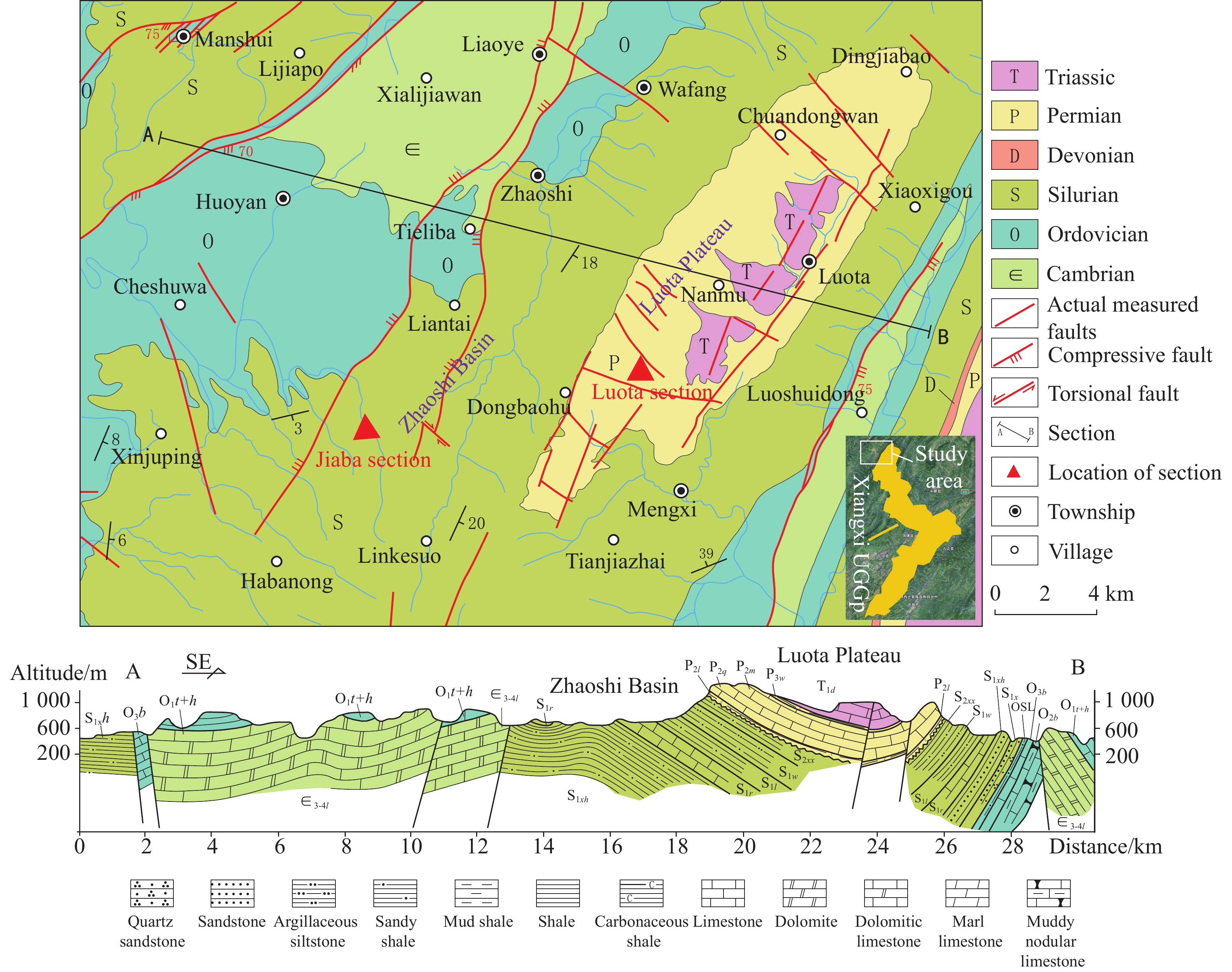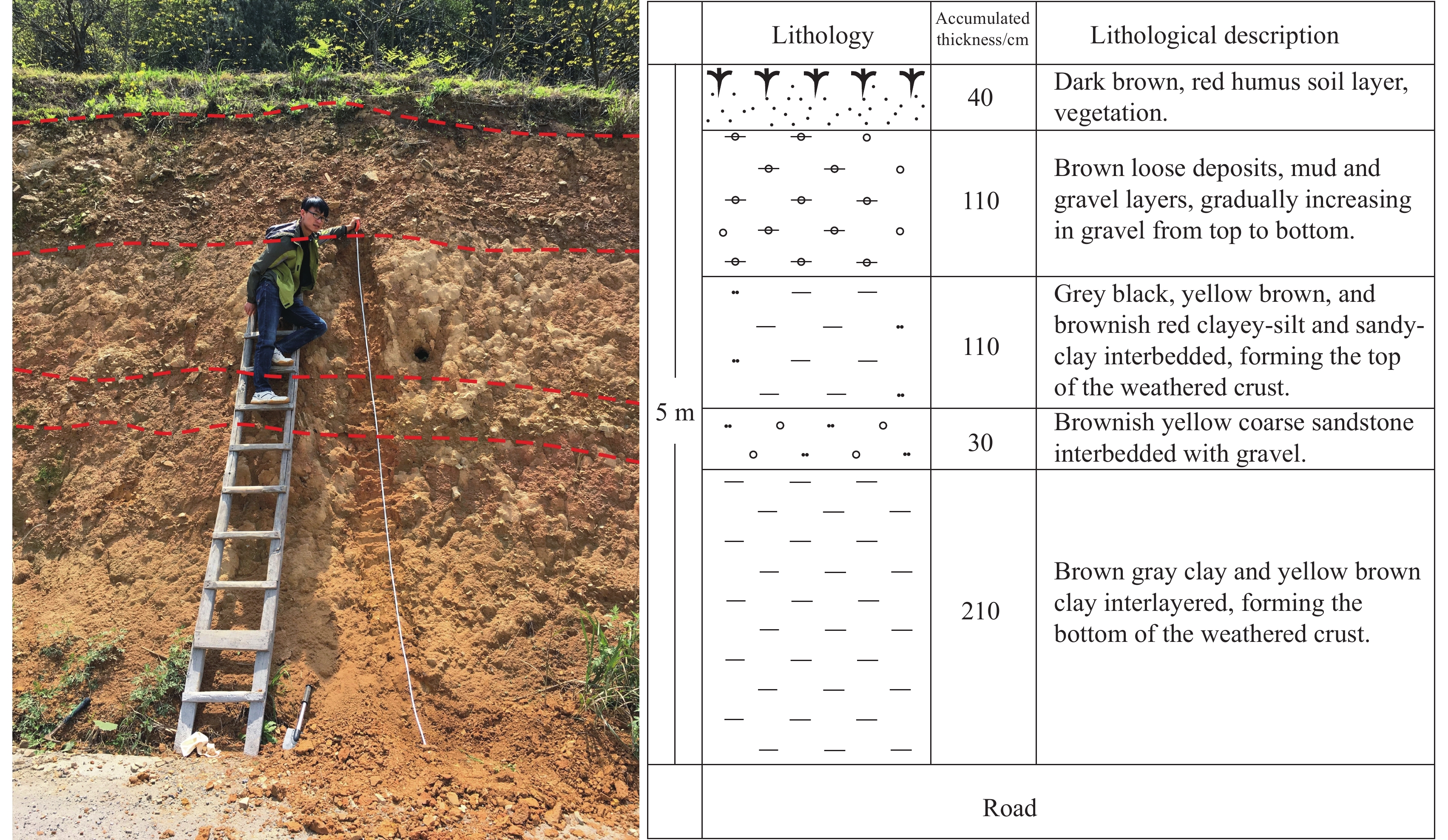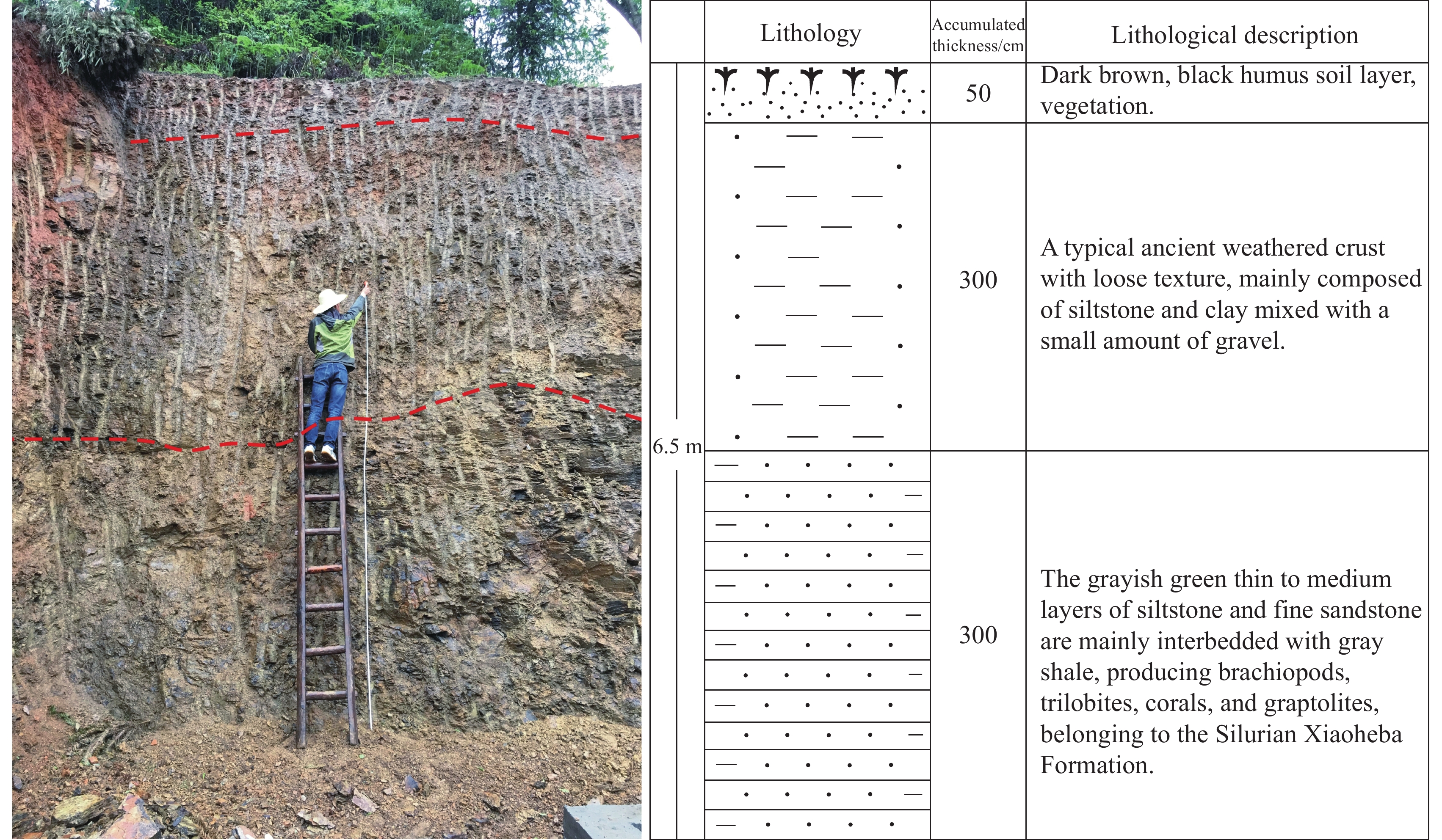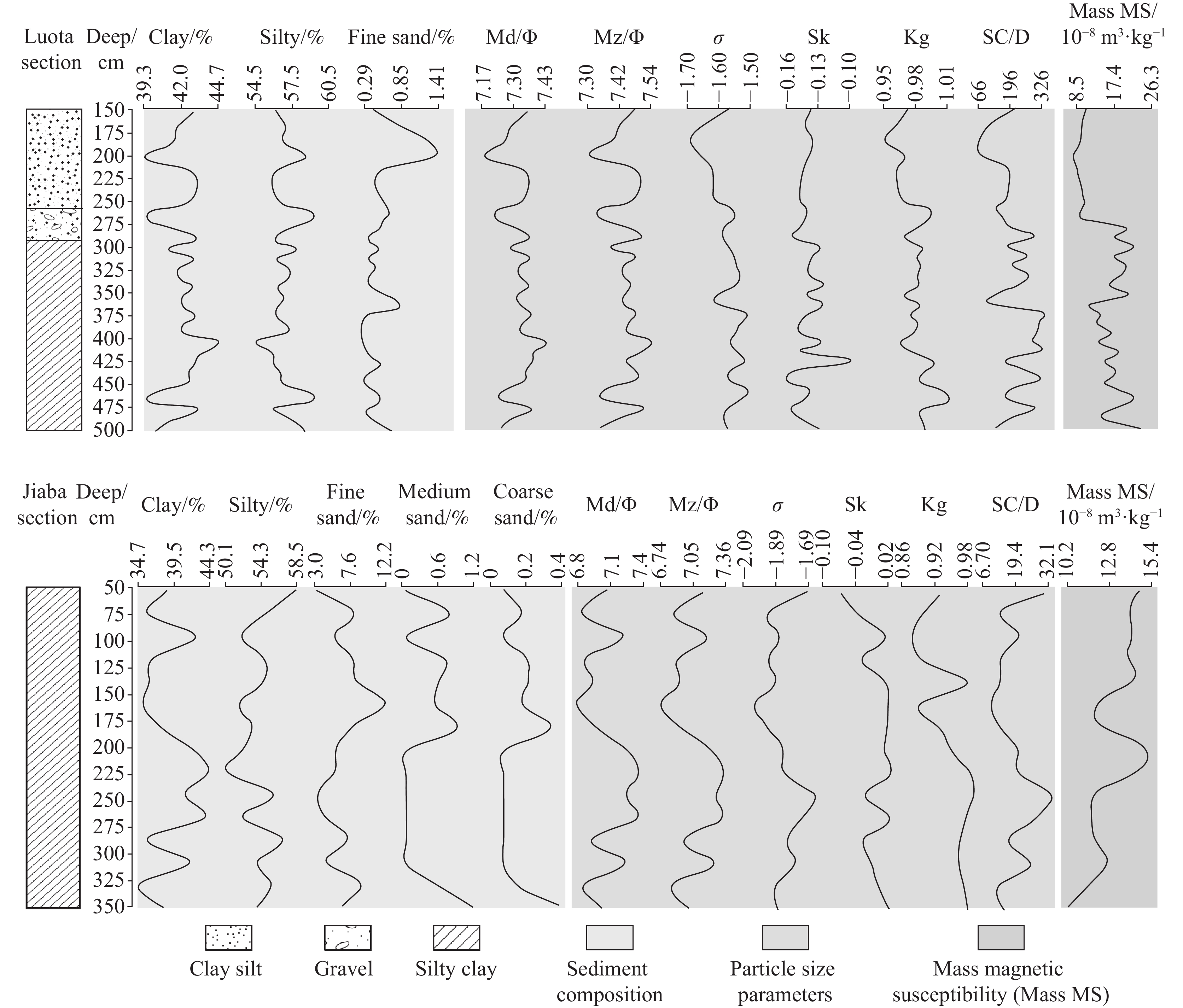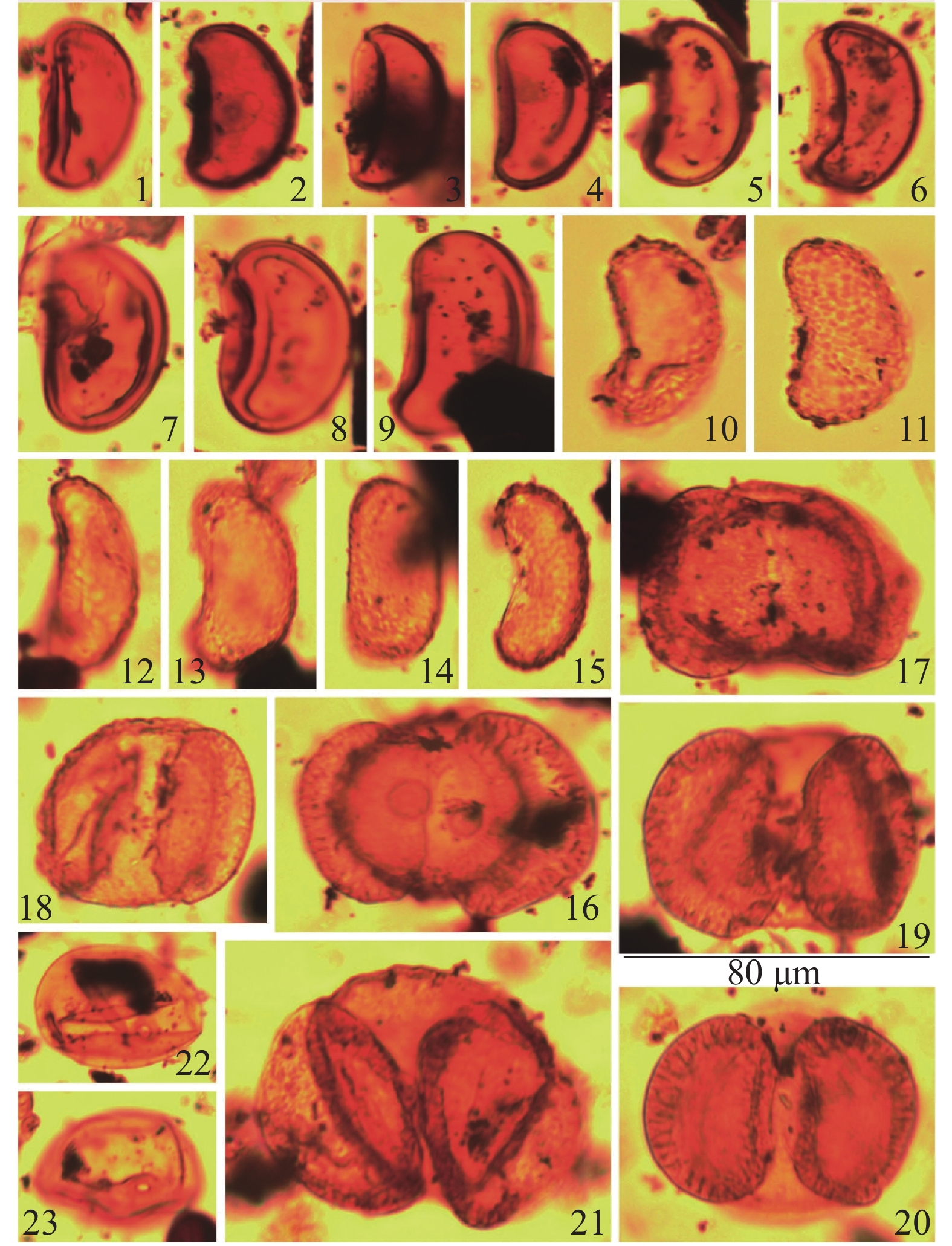| Citation: | WU Liangjun, WANG Pujun, ZHANG Jing, XIN Cunlin, RONG Yuebing, CHEN Weihai, ZHANG Yuanhai, HUANG Chao. Sedimentary and palaeoclimatic characteristics of planation surface at the edge of typical karst plateau: A case study of Luota and Jiaba sctions in Xiangxi[J]. Carsologica Sinica, 2024, 43(2): 253-271. doi: 10.11932/karst20240202 |
Sedimentary and palaeoclimatic characteristics of planation surface at the edge of typical karst plateau: A case study of Luota and Jiaba sctions in Xiangxi
-
Abstract
The palaeoenvironment has an important influence on the formation and evolution of karst geomorphology, and the planation surface at the edge of the karst plateau is one of the important recorders. The Yunnan−Guizhou Plateau is an important karst plateau in China, on the southeast edge of which is located Xiangxi in Hunan Province—a deep cut platform and gorge development area. Xiangxi is also a combination zone of low mountains and middle mountains at the edge of the Yunnan−Guizhou Plateau, in which the high plain transits to the alluvial plain, with rich records of planation surfaces. These planation surfaces are characterized by rapid altitude changes, different weathering crust materials and different types of bedrock lithology. However, the weathering crust properties and palaeoclimate characteristics of these planation surfaces are still unclear. Therefore, we choose two weathering crusts representing the elevation of 1,400 m and 600−700 m of planation surfaces in Luota Period (Luota section) and Zhaoshi Period (Jiaba section) as study objects. In this study, conducting the inversion of palaeoclimate indicated by weathering crusts of planation surfaces through grain size, magnetic susceptibility and sporopollen analyses, we hope to provide more evidence for the development characteristics of planation surfaces and palaeoclimate evolution on the edge of the Yunnan−Guizhou Plateau.
Results show that the weathering crust of Luota section is 5.0 m thick and can be divided into 5 layers. The lithology is mainly composed of humus, gravel layer, silt, clay, etc. The content of silt with sizes ranging from 5 to 50 μm is the highest, accounting for 57.6%; the average content of clay is 41.9%; the sand content is the lowest, at 0.56%, all of which are fine sand. The weathering crust in Jiaba section is 3.5 m thick and can be divided into two layers. The lithology is mainly composed of humus, silty, clay and a small amount of gravel. The content of silt with sizes ranging from 5 to 50 μm is also the highest, accounting for 54%; the average content of clay is 39%. In addition, the analyses of Md, Mz, σ, Sk, Kg, SC/D values, magnetic susceptibility and other indicators show that there appear multiple index fluctuations in both Luota and Jiaba sections, but the fluctuation range of Jiaba section is relatively limited. The types of sporopollen in the two sections are different. Luota section is mainly composed of Polypodium and Pinus, with a small number of Abies, Podcarpus and Chenopodium. The main sporopollen components of Jiaba section are Polypodium and Pinus, and a few Gramineae and Carpinipites are found. The types of sporopollen in Jiaba section are fewer than those in Luota section, and the concentrations are also lower. Based on the development of Polypodium in both sections, it is supposed that the climate during the sedimentary period of weathering crust was warm and hot. However, the climate during the sedimentary period of Luota section may have been a warm climate with high humidity, while the climate of Jiaba section may have been a cool and humid climate with low humidity. In addition, according to the analysis of sporopollen and the previous data, it is speculated that the weathering crust of Luota section may have been formed in the early Neogene, and the planation surface may have been formed in the Miocene. The weathering crust of Jiaba section may have been formed in the early Quaternary, and the planation surface may have been formed in the Pleistocene.
-

-
References
[1] REN Xuemei, CHEN Zhong, LUO Lixia, ZHOU Xinqin, WANG Jianli. Summary on the study of planation surface[J]. Scientia Geographica Sinica, 2003, 23(1): 107-111. [2] Coltorti M, Ollier C D. Geomorphic and neotectonic evolution of the Ecuadorian Andes[J]. Geomorphology, 2000, 32(1): 1-19. [3] [4] [5] 李吉均. 青藏高原隆起的三个阶段及夷平面[M]. 北京: 中国环境科学出版社, 1995: 1-5. [6] [7] LI Dewen, CUI Zhijiu. Karst planation surface and the Qinghai-Xizang Plateau uplift[J]. Quaternary Sciences, 2004, 24(1): 58-63. [8] PAN Baotian, GAO Hongshan, LI Jijun. On problems of planation surface: A discussion on the planation surface in Qinghai-Xizang Plateau[J]. Scientia Geographica Sinica, 2002, 22(5): 520-526. [9] LI Dewen, CUI Zhijiu, LIU Gengnian. A development model of red weathering crust on limestones: An example from Hunan, Guangxi, Guizhou, Yunnan and Xizang[J]. Acta Geographica Sinica, 2002, 57(3): 293-300. [10] PENG Hanxing, WU Yingke. Geochemical characteristics of the Quaternary sediments in Luota karst region[J]. Carsologica Sinica, 1985, 4(4): 39-46. [11] LAO Wenke, LI Zhaolin, LUO Weiquan, LIANG Bin. Main features and classification of epikarst in Luota area[J]. Carsologica Sinica, 2002, 21(1): 32-37. [12] LI Jijun, FANG Xiaomin, PAN Baotian, ZHAO Zhijun, SONG Yougui. Late Cenozoic intensive uplift of Qinghai-Xizang Plateau and its impacts on environments in surrounding area[J]. Quaternary Sciences, 2001, 21(5): 381-391. [13] 吴忱, 马永红, 张秀清, 马永红, 赵明轩. 华北山地地形面、地文期与地貌发育史[M]. 石家庄: 科学技术出版社, 1999: 245-252. [14] FENG Jinliang. Researches in planation surfaces and weathering mantles[D]. Beijing: Peking University, 2002. [15] WANG Jing'ai, ZUO Wei. Geographic atlas of China[M]. Beijing: Sinomaps Press, 2010. [16] JIANG Zhongcheng, ZHANG Jing, HUANG Chao, RONG Yuebing, WU Liangjun. Causes of formation and geo-scientific significance of karst gorge group in Xiangxi geopark[J]. Carsologica Sinica, 2019, 38(2): 269-275. [17] Wu Liangjun, Jiang Haixian, Chen Weihai, Peng Wenhong. Geodiversity, geotourism, geoconservation, and sustainable development in Xiangxi UNESCO Global Geopark: A case study in ethnic minority areas[J]. Geoheritage, 2021, 13(99): 1-18. [18] WU Liangjun, CHEN Weihai, RONG Yuebing, ZHANG Jing, HUANG Chao, ZHU Haiyan, MENG Qingxin, WU Jiwen, LUO Qukan, BAI Bing, OU Mengmeng. Development characteristics and research value of red carbonate stone forest in the Xiangxi geopark[J]. Carsologica Sinica, 2020, 39(2): 251-258. [19] CHEN Changming. On the new tectogenesis of northwestern Hunan[J]. Hunan Geology, 1988, 7(2): 64-72. [20] JIN Liduo, LV Zhongyuan, LIN Yushi, ZHANG Shunzhi. Karst development in Luota area, west Hunan[J]. Carsologica Sinica, 1983, 2(1): 19-30. [21] CHEN Anze. Karst stone forest landscapes in China[M]. Beijing: Science Press, 2011. [22] YU Haoran, WU Yingke. An outline of karst geology in Luota region[J]. Carsologica Sinica, 1982, 1(1): 33-39. [23] YIN Jianjun. Climate change in the past 2000 years revealed by stalagmites from Lianhua cave in northwest Hunan, China[D]. Chongqing: Southwest University, 2013. [24] ZHANG Huiling, YU Kefu, ZHAO Jianxin, FENG Yuexing, LIN Yushi, ZHOU Wei, LIU Guohui. Variations in deposition rate of sedimentary cycle from a stalagmite in Lianhua cave and its paleoclimatic implications during the mid-late Holocene[J]. Carsologica Sinica, 2017, 36(4): 580-590. [25] JIANG Duanwu, LI Daming, MEI Jinhua. Karst circle in westnorthern Hunan and its neotectonics remote sensing interpretation information[J]. Hunan Geology, 2001, 20(3): 225-229. [26] [27] LIANG Enyun, LIU Wei, LIU Yaorong, HUANG Leqing, LIU Gengyan, PENG Nengli, CAO Jiehua. Research on sedimentary tectonic metallogenic of Hongyanxi area in the northwest Hunan[J]. Geological Survey of China, 2016, 3(4): 29-36. [28] LI Bin, HU Bowen, LUO Qun, JIN Changhao, WANG Yilin. Tectonic sequence and sedimentary evolution in western Hunan[J]. Marine Origin Petroleum Geology, 2018, 23(1): 1-12. [29] LAO Wenke, JIANG Zhongcheng, SHI Jian, LIANG Bin. Hydrogeologic structure and feature of the epi-karst in Luota[J]. Carsologica Sinica, 2003, 22(4): 9-17. [30] DU Yuchao, LIANG Bin, LI Zhaolin. Groundwater dynamics analysis of the saturated karst zone of Luota in Hunan Province[J]. Ground Water, 2006, 28(2): 48-52. [31] SU Chuntian, PAN Xiaodong, TANG Jiansheng, ZOU Shengzhang, LIANG Xiaoping, LI Zhaolin. Influence of eco-environment on hydrogeochemical of epikarst springs in Luota, west Hunan Province of China[J]. Mountain Research, 2014, 32(2): 205-211. [32] LAN Funing, WANG Wenjuan, WU Huaying, JIANG Zhongcheng, QIN Xiaoqun, AN Shuqing. Temporal and spatial distributions of CO2 in soil and their influencing factors under different LUCC: A case study of the Dalongdong underground river drainage area[J]. Carsologica Sinica, 2017, 36(4): 427-432. [33] XU Shujian, PAN Baotian, ZHANG Hui, LI Qiong. Grain size parameters of loess-palaeosol deposits from graphic and moment methods: A comparative study[J]. Arid Land Geography, 2005, 28(2): 194-198. [34] ZUO Hailing. The sedimentary environmental evolution since the Holocene in the Maqu plateau recorded by Langqu section[D]. Lanzhou: Northwest Normal University, 2016. [35] [36] Ding Zhongli, Sun Jimin, Liu Dongsheng. A sedimentological proxy indicator linking changes in loess and deserts in the Quaternary[J]. Science in China, 1999, 42(2): 146-152. doi: 10.1007/BF02878513 [37] ZHANG Wenli. The desertification evolution reflected by grain-size and magnatic susceptibility in Maqu plateau since Middle-late Holocene[D]. Lanzhou: Northwest Normal University, 2015. [38] [39] [40] LIU Bing, JIN Heling, SUN Zhong, SU Zhizhu, ZHANG Caixia. Geochemical characteristics of Aeolian deposits in Gonghe basin, northeastern Qinghai-Xizang Plateau and the indicating climatic changes[J]. Advances in Earth Science, 2012, 27(7): 788-799. [41] YU Xuefei, LI Baosheng, JIN Heling, LV Yuxiao. Grain-size cycles during the last interglacial period in the Salawusu river valley responding to the past global change[J]. Journal of South China Normal University (Natural Science Edition), 2004, 31(1): 129-135. [42] HU Mengjun, LI Sen, GAO Shangyu, ZHANG Dengshan. Evolution process of land desertification around Qinghai lake since 32 ka BP reflected by sediment grain-size features[J]. Journal of Desert Research, 2012, 32(5): 1240-1247. [43] LI Shan, WU Huaichun, FANG Qiang, XU Junjie, SHI Meinan. Cyclostratigraphy of the Devonian/Carboniferous boundary sections in South China[J]. Earth Science Frontiers, 2022, 29(3): 329-339. [44] WANG Jian, LIU Zechun, JIANG Wenying. A relationship between susceptibility and grain-size and minerals, and their paleo-environmental implications[J]. Acta Geographica Sinica, 1996, 51(2): 155-163. [45] Ellwood B B, Crick R E, Hassani A E, Benoist S L, Young R H. Magnetosusceptibility event and cyclostratigraphy method applied to marine rocks: Detrital input versus carbonate productivity[J]. Geology, 2000, 28(12): 1135-1138. doi: 10.1130/0091-7613(2000)28<1135:MEACMA>2.0.CO;2 [46] XUE Xiangxu, ZHAO Jingbo. Characteristics and significance of the micromorphology of Neogene red clay of Xunyi, Shaanxi Province[J]. Acta Sedimentologica Sinica, 2003, 21(3): 448-451,481. [47] Stage M. Magnetic susceptibility as carrier of a climatic signal in chalk[J]. Earthand Planetary Science Letters, 2001, 188(1-2): 17-27. doi: 10.1016/S0012-821X(01)00304-1 [48] Rey D, Rubio B, Mohamed K, Vilas F, Alonso B, Ercilla G, Rivas T. Detrital and early diagenetic processes in Late Pleistocene and Holocene sediments from the SW Galicia Bank inferred from high-resolution enviromagnetic and geochemical records[J]. Marine Geology, 2008, 249(1-2): 64-92. doi: 10.1016/j.margeo.2007.09.013 [49] Hladil J, Cejchan P, Babek O, Koptikova L, Navratil T, Kubinova P. Dust-A geology-orientated attempt to reappraise the natural components, amounts, inputs to sediment, and importance for correlation purposes[J]. Geologica Belgica, 2013, 13(4): 367-384. [50] Maher B A. The magnetic properties of Quaternary Aeolian dusts and sediments, and their palaeoclimatic significance[J]. Aeolian Research, 2011, 3(2): 87-144. doi: 10.1016/j.aeolia.2011.01.005 [51] Han J M, Jiang W Y, Liu D S, Lyu H Y, Guo Z T, Wu N Q. Carbonate isotopic records of paleoclimate changes in Chinese loess[J]. Science in China (Earth Sciences), 1996, 39(5): 460-467. [52] [53] 施雅风. 中国全新世大暖期气候与环境[M]. 北京: 海洋出版社, 1992: 1-212. [54] GONG Shengli, BI Ligang. Palynological sedimentation and its relationship with Neogene sedimentary environment in PL19-3 area[J]. China Offshore Oil and Gas (Geology), 2001, 15(6): 388-392. [55] FENG Xiaohua, YAN Shun, NI Jian. Pollen-based reconstruction of vegetation in Xinjiang during the Holocene[J]. Quaternary Sciences, 2012, 32(2): 304-317. [56] SHAO Zhaogang, MENG Xiangang, ZHU Dagang, YANG Chaobin, LEI Weizhi, WANG Jin, HAN Jian'en, YU Jia, MENG Qingwei, QIAN Cheng, HE Chengguang. Sporopollen record in the Kongma basin of the Naqu, Xizang, and their environmental significance[J]. Earth Science: Journal of China University of Geosciences, 2013, 38(Suppl.1): 1-9. [57] WANG Weiming. Progress and prospect of studies on palynology in China[J]. Acta Palaeontologica Sinica, 2009, 48(3): 338-346. [58] [59] LV Kexin, SHI Guangyao, ZHANG Huan, ZHANG Jinlong, LI Qingzhe, ZHANG Pengcheng. Quaternary palynological records and climatic signifiance of S9 borehole in Sanhe City of Hebei plain[J]. Geological Survey of China, 2022, 9(1): 64-72. [60] CHEN Ping, WANG Ren, QIN Jungan, YANG Rui, LI Jun, RUAN Zhimei. Oligocene–Miocene palynostratigraphy and paleoclimate of Well WN-A from deep water area, southeast Hainan basin[J]. Journal of Jilin University: Earth Science Edition, 2022, 52(2): 390-402. [61] YU Junjie, PENG Bo, LAN You, WU Bin, WANG Jilong, DING Dalin, LAO Jinxiu, LI Shuaili, DAI Lu. Palynological record revealed anthropogenic deforestation, sea level and climate changes since marine isotope stage 5a in the northeastern coast of Fujian Province[J]. Earth Science, 2021, 46(1): 281-292. [62] ZHAO Zengyou. A study on human activities changes and its impact on envirionment during the past 1600 years in Guangxi and Chongqing, based on pollen-spore and charcoal data[D]. Chongqing: Southwest University, 2013. [63] ZHOU Jianchao, QIN Jungan, ZHANG Qiang, ZHANG Chunlai, JIANG Shiqing. Vegetation, climate and depositional environment changes since the middle Holocene in the karst area of Guilin, Guangxi[J]. Chinese Science Bulletin, 2015, 60(13): 1197-1206. doi: 10.1360/N972014-00744 [64] WANG Qirong, JIANG Yongjun, HAO Xiudong, QIAO Yina, ZHANG Caiyun, MA Lina, MAO Yang, LV Tongru, QIU Ju. A 700-year record of vegetation and rocky desertification evolution based on palynological data of the karst valley area, Chongqing City, China[J]. Acta Ecologica Sinica, 2021, 41(9): 3634-3644. [65] PAN Ninghui. The climate and environmental evolution and aeolian activity since the Holocene in the Gonghe basin recorded by Masi section[D]. Lanzhou: Northwest Normal University, 2017. [66] WANG Yong, CAI Yunfeng, LI Guo, LIU Mengjiao, ZHANG Yaohua. On soil magnetic susceptibility of karst district of Chongqing under different rocky desertification[J]. Journal of Southwest China Normal University (Natural Science Edition), 2016, 41(11): 49-55. [67] 吴正. 风沙地貌学[M]. 北京: 科学出版社, 1987. [68] 于寒, 黄书捷. 湘江下游漫滩沉积物粒度和磁化率特征研究[C]//第31届中国气象学会年会S11 第三届城市气象论坛—城市与环境气象, 2014. [69] [70] GONG Shuhua, ZHU Lifen. Influence of geological and geomorphologic features on karst rocky desertification in northwestern Hunan Province: A case study of Zhangjiajie City[J]. Carsologica Sinica, 2021, 40(3): 504-512. [71] XIE Shiyou, YUAN Daoxian, WANG Jianli, KUANG Mingsheng. Features of the planation surface in the surrounding area of the Three Gorges of Yangtze[J]. Carsologica Sinica, 2006, 25(1): 40-45. [72] WU Jiwen, WU Liangjun, LV Yong, WANG Pujun, ZHOU Jiaming, LIN Yu, PAN Ming, LIAO Jiafei, MENG Qingxin. Transpressional structure and its control on development of Yinchangping dolomite karst system in Lushui City, Yunnan[J]. Carsologica Sinica, 2021, 40(5): 793-804. [73] LUO Shuwen, HE Wei, YANG Tao, DENG Yadong, LV Yong, WU Kehua, MENG Qingxin. Geological significance of the development characteristics of karst geomorphology and its formation mechanism in Hunan-Guangxi corridor[J]. Carsologica Sinica, 2021, 40(5): 750-759. -
Access History

-
Figure 1.
Elevation profile of the karst area in Southwest China and distribution of the planation surface in Xiangxi
-
Figure 2.
Geology of Luota−Zhaoshi area in Xiangxi
-
Figure 3.
Realistic view of the planation surface in Luota period and Zhaoshi period
-
Figure 4.
Stratigraphic histogram of Luota section
-
Figure 5.
Stratigraphic histogram of Jiaba section
-
Figure 6.
Vertical variation characteristics of sediment composition, particle size parameter and magnetic susceptibility of weathering crusts in Luota section and Jiaba section
-
Figure 7.
Sporopollen assemblage chart of Luota section and Jiaba section

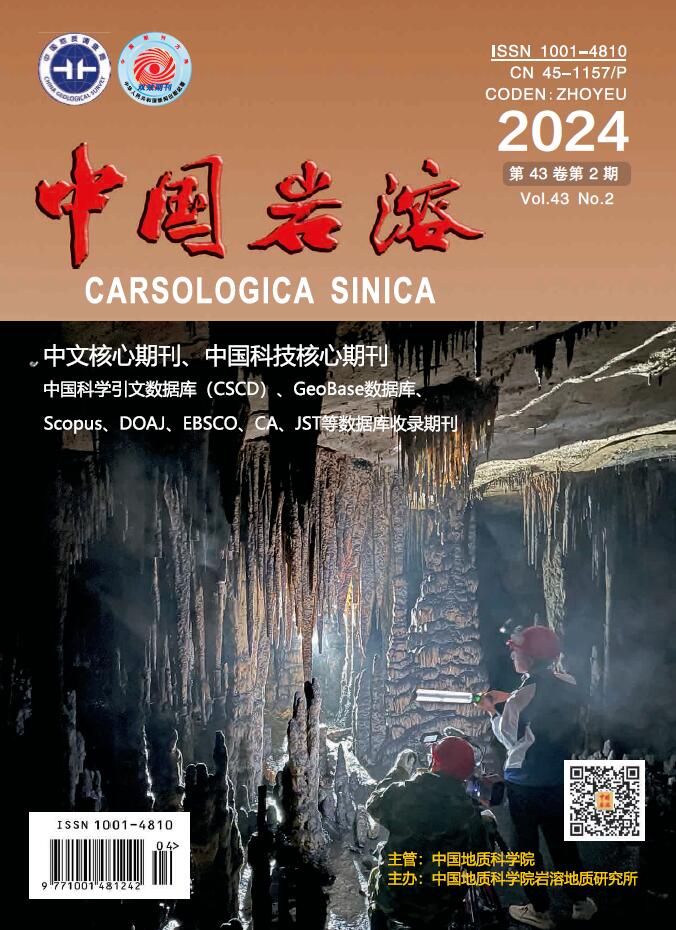

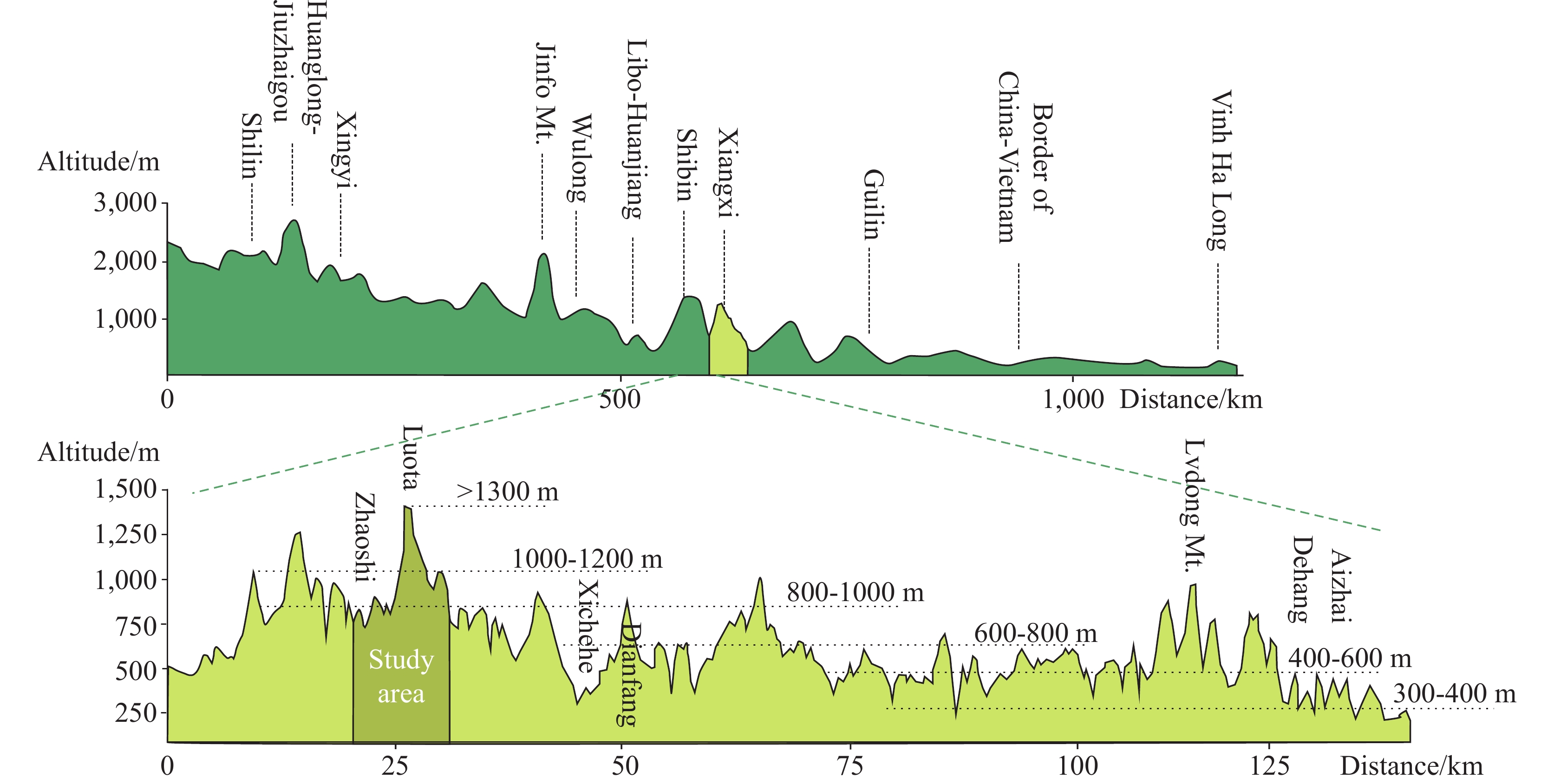

 DownLoad:
DownLoad:
